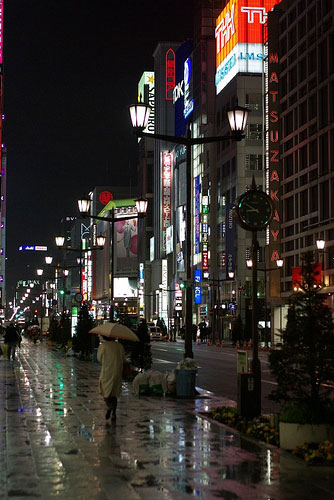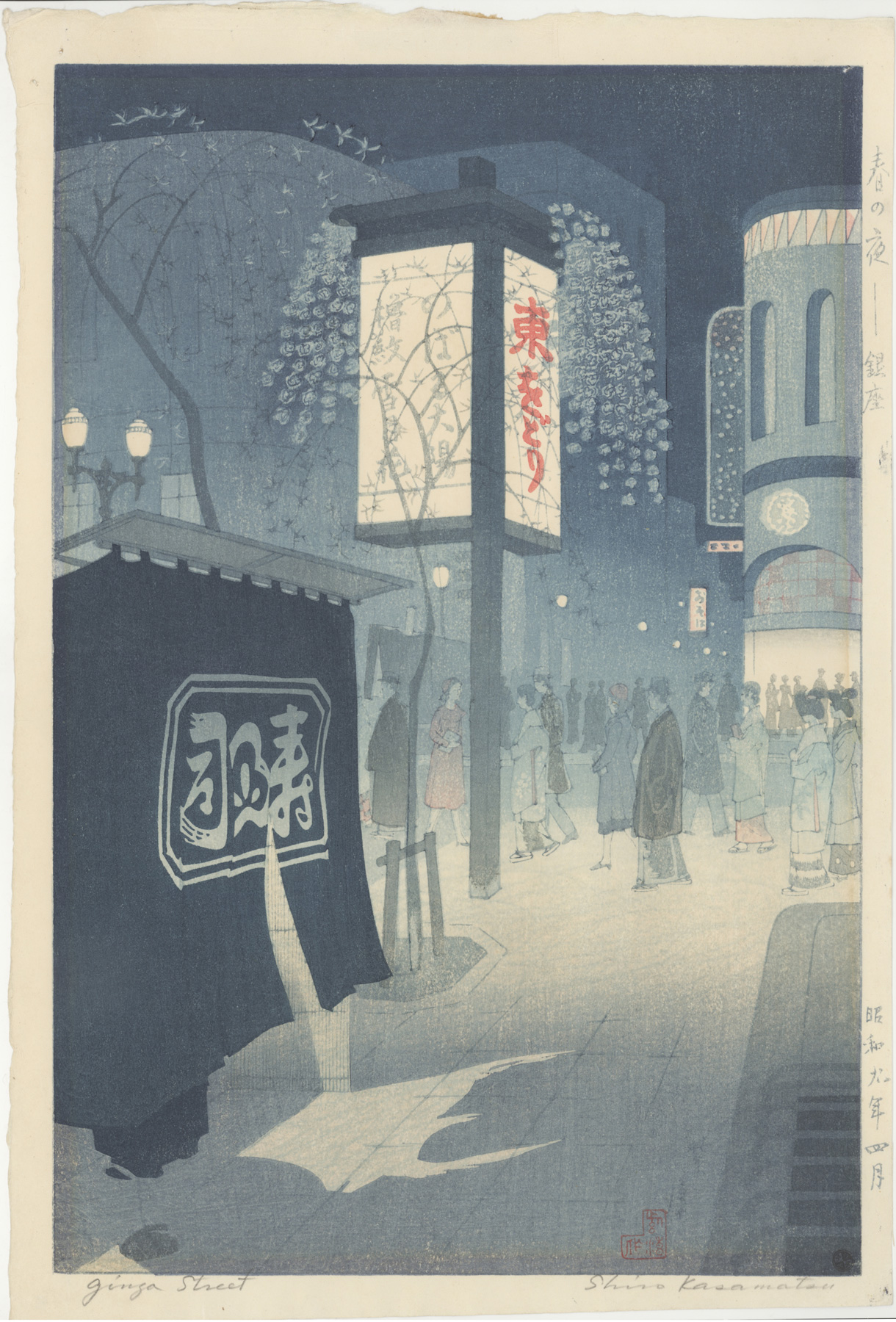Source: The Japanese Print Since 1900: Old dreams and new visions, Lawrence Smith, British Museum Publications, Ltd., 1983, p. 102
In the foreground is a stall selling sushi (a dish of cold rice, fish or vegetables and seaweed), and in the middle ground a lantern advertising the spring theater performances. The background is filled by the very typical between-the-Wars buildings of the Tokyo entertainment area. Among these inanimate features the people, in a mixture of Western and Japanese dress, seem shadowy and uncertain. Shiro was in the 1930s very sensitive to this introverted atmosphere and has recorded it with a poetic skill which he never regained after the catastrophe of the War.
Source: Printed to Perfection: Twentieth-century Japanese Prints from the Robert O. Muller Collection, Amy Reigle Newland, et. al., Hotei Publishing, 2004, p. 113.
This piece stands as one of Shiro’s most delightful designs: a view of the bustling Ginza district in Tokyo during the 1930s, with a street side food stall to the left, and on the right a large advertisement for the traditional geisha dance, azuma odori (literally, “dance of the Eastern Capital [Tokyo]”). Alexandra Marmion suggests that in his prints Shiro attempts to poeticize, or “Edocize,” the most aggressively modern district of Tokyo by eliminating any reference to modern culture and defining the subject through elements with romantic, nostalgic connotations – the blossoming cherry tree, the food stall, and the reference to Edo in the advertisement.
Source: Modern Japanese Woodblock Prints - The Early Years, Helen Merritt, University of Hawaii Press, 1990, p. 61
Shiro was particularly adept at suggesting nuances of weather and atmosphere of specific times and places. In "Spring Night - Ginza," 1934, he provides a nostalgic glimpse of the Ginza of budding willows and soft lights before it became a carnival of flashing neon. The picturesque food stand, the signs, and the strolling people are all infused with the magic of the still night air.
Source: Terrific Tokyo A Panorama in Prints from the 1860s to the 1930s, Elizabeth de Sabato Swinton, Worcester Art Museum, 1998, p. 38
Before the Great Kanto Earthquake (1923), only the northern part of present-day Ginza was known by that name. During the 1920s, it grew into a major entertainment area, and the number of drinking places doubled. Sarari-man (salary-men, white-collar workers) flocked to its bars, cafes, dance halls, and cabarets.
Kasamatsu Shiro depicts Ginza on a mild spring night when the new leaves are just opening on the area's famous willow trees. The artist's use of blue to suggest the color of night when it is illuminated by street lamps and signs is quite lyrical. Crowds of men and women, well dressed in both Japanese and Western clothing, fill the streets. The dancers in the round dance hall at the upper right are silhouetted by the interior lighting. A man stands within the closed curtain of the sushi bar at the lower left. The lighted sign of a soba (noodle) shop down the street is easily read. Men on their way home from a night of drinking or the theater would pop into places like this for a quick bite to eat. Images such as this one surely inspired the use of the name Ginza for busy shopping and entertainment areas throughout the country.
Notes on the Original Edition
Source: Dorothy Blair, Modern Japanese Prints, The Toledo Art Museum 1997, plate 171 (Printed from a photographic reproduction of two exhibition catalogues of modern Japanese prints published by The Toledo Museum of Art in 1930 and 1936)Evening on the Ginza, the famous shopping street of Tokyo. 14 5/16" x 9 3/8" Signed at lower left, Shiro; red seal, "Shiro In" (Shiro's mark). Right margin: the Japanese title; the date, "Showa Ku Nen Shi Gatsu" (4th Month of the 9th Year of Showa [April 1934]). Left margin: copyright stamp of the publisher, Watanabe of Tokyo. Blocks, about 20; superimposed printings, about 25; edition 100.

A Rainy Night on the Ginza Today
Print Details
| IHL Catalog | #217 |
| Title | Spring Night in Ginza 春の夜 銀座 Haru no Yoru, Ginza |
| Series | |
| Artist | Kasamatsu Shirō (1898–1991) |
| Signature | no signature on this edition |
| Seal |  |
| Date |  昭和九年四月 April 1934 (see "Edition" below) |
| Edition | Later c. 1946-1957 edition with 6mm Watanabe seal in lower right hand corner of image as shown below |
| Publisher | seal reading ワタナベ Watanabe [Marks: seal 08-034; pub. ref. 576] |
| Impression | excellent |
| Colors | good |
| Condition | good - minor mat burn; slight overall toning; slight color fading; brown tape top center verso; shallow two inch fold 1/3 down from top |
| Miscellaneous | “ginza street” and “shiro kasamatsu” penciled in bottom margin, most likely by publisher |
| Genre | shin hanga (new prints) |
| Format | ōban tate-e |
| H x W Paper | 15 3/8 x 10 3/8 in. (39 x 26.4 cm) |
| H x W Image | 14 1/4 x 9 3/8 in. (36.2 x 23.8 cm) |
| Collections This Print | The British Museum 1981,0225,0.4.b (6mm Watanabe round seal lower right); Museum of Fine Arts, Boston 50.274 (with Watanabe E-type seal); National Museum of Modern Art, Tokyo P00211-012 (unknown edition); Smithsonian Freer Gallery of Art and Arthur M. Sackler Gallery S2003.8.473 (with Watanabe E-type seal); MAK Vienna: Austrian Museum of Applied Arts/Contemporary Art K.I. 13606-0034 (6mm Watanabe round seal lower right; Jordan Schnitzer Museum of Art MWJ51:K7 (E-type Watanabe publisher seal); Worcester Museum of Art 1998.54 (6mm Watanabe round seal lower right) |
| Reference Literature | Catalogue Raisonné: W-15 as listed in Shiro Kasamatsu - The Complete Woodblock Prints, Dr. Andreas Gund, self-published by the author, 2001, Tokyo; Printed to Perfection: Twentieth-century Japanese Prints fromthe Robert O. Muller Collection, Amy Reigle Newland, et. al., HoteiPublishing, 2004, p. 113, plate 103; Modern Japanese Woodblock Prints - The Early Years, Helen Merritt, University of Hawaii Press, 1990, p. 61; The Japanese Print Since 1900: Old dreams and new visions, Lawrence Smith, British Museum Publications, Ltd., 1983, p. 87, plate 82, p. 102; Terrific Tokyo A Panorama in Prints from the 1860s tothe 1930s, Elizabeth de Sabato Swinton, Worcester Art Museum, 1998, p.38, pl. 8; The Changing City as Depicted in Modern Woodblock Prints - Tokyo in Transition, Edo-Tokyo Museum, 1996, p. 75; Hanga ni miru Tokyo no fukei; Kanto daishinsai kara senzen made, Ota Kuritsu Kyodo Hakubutsukan, 2002, pl. 234, p. 59. |
8/17/2021
8/6/2018



